Do you live or work in an area with mediocre signal coverage for your mobile phone carrier? I know how frustrating it can be to have a weak signal, receive a call and have it drop right in the middle of an important conversation. Been there, done that… That’s why I continue to look for inexpensive ways to boost my AT&T signal. My latest potential solution is the Cell Ranger PORT from Mogo Wireless, Inc.
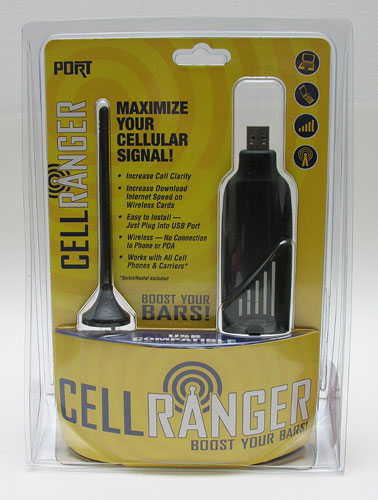
The Cell Ranger is available in a USB version and a 12V version for your vehicle. This product claims to boost your cellular signal by 2-3 bars, increase call clarity and increase 3G download speeds up to 200%. Wow, those are pretty bold claims… By the way, the Cell Ranger works with every cellular carrier except Sprint/Nextell. The packaging says that it is made to boost 800Mhz and 1900Mhz. AT&T is 850Mhz, so I’m a little confused, but let’s give it a try…
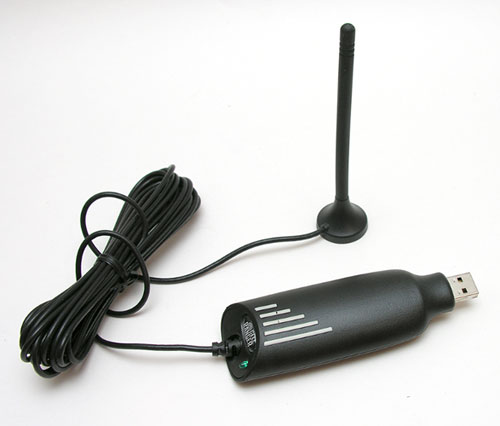
The USB version is called the PORT and is shown above. The 12V version called the STIX looks the same except that it has a 12V connector instead of a USB connector. Both versions have a 4.75 inch antenna with a magnetic base and 15ft of cable. The connector end has a small Green LED that lights up when it is connected to a live USB port (or power port in your car).
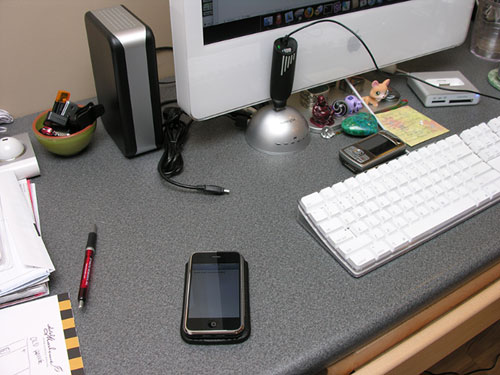
Setting up the Cell Ranger should be easy, but it all depends on where you need your cellular signal boosted. For example, the place where my AT&T signal is the weakest, is in my basement office. The instructions tell you to place the antenna in a location where the signal is stronger and make sure that you use all 15 feet of the cable. It’s also supposed to work better if the antenna is separated from the Cell Ranger connector by a wall or obstacle so that the line of sight is blocked.
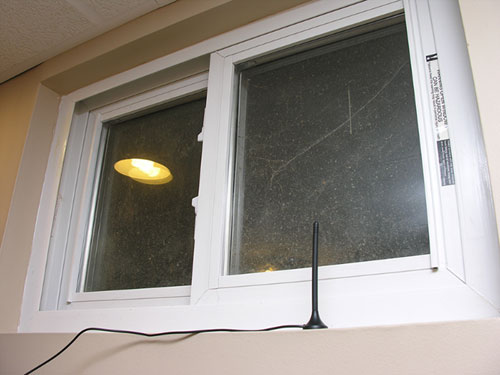
Testing in a basement office with a weak signal
In my office, I placed the antenna on the basement windowsill and plugged the other end into a powered USB hub in my iMac about 10 ft away. I then went into the Field Test mode on my 2G iPhone (dial *3001#12345#*) and kept an eye on the upper Left corner of the iPhone’s display.
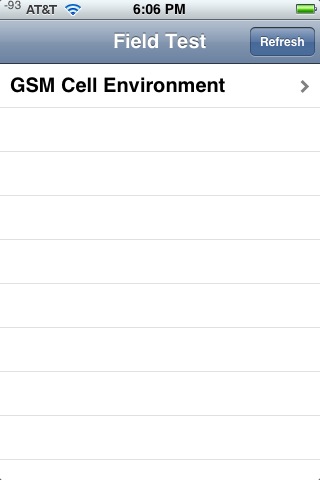
In the image above, you see a reading of -93. That’s a pretty crummy signal. The less negative the value is, the stronger the signal. So for example, -95 is a weak signal and -70 is a stronger signal. As you can see, my signal is not very good at all. For a couple hours I conducted several tests where I compared the field test meter with the Cell Ranger connected and then disconnected. For all the test, I had the iPhone within 1 to 6 feet of the Cell Ranger connector. The results weren’t good, but were pretty consistent. Here are two average readings:
-91 without Cell Ranger, -99 with Cell Ranger
-93 without Cell Ranger, -93 with Cell Ranger
I thought that the bad performance must have something to do with the fact that I wasn’t blocking the line of sight as suggested. So I scrounged around in one of my gadget drawers and found an AC adapter with a USB socket. I unplugged the Cell Ranger from my iMac, plugged it into the AC adapter and then plugged the AC adapter into a wall socket on the back wall of my office. I then ran the antenna cable out the door and placed the antenna on one of the steps leading upstairs. Unfortunately, the readings weren’t any different with this setup. They continued to stay around -91 to -95 with or without the Cell Ranger plugged in. Not impressive so far…
Before I gave up on this product, I decided to try two more tests in a totally different location – the office and lab building where I work during the day.
Testing in a office building with good signal
The first test was at my cube. I have a good signal here and normally do not have any problems with dropped calls. I placed the magnetic antenna base on a file cabinet around the corner from my cube and then plugged the Cell Ranger USB connector into my Dell laptop.
Here are the iPhone field test readings that I recorded in approximately 30 minutes time:
-85, -83, -93, -87 without Cell Ranger, -77, -85, -77 with Cell Ranger
-77 nice! Finally a higher reading. Which probably leads you to realize an important fact… you have to have a good signal before you can make it better. But let’s try one more test.
Testing in a lab building
For this test, I’m also going to test it with a Verizon phone along with my iPhone. My friend who works in the lab building is always complaining about dropped calls, so we’ll see if the Cell Ranger helps him. I won’t be able to see field test strength numbers for the Verizon phone, but we’ll see if we can tell a difference by making and receiving calls.
We setup the Cell Ranger in a similar fashion as before (with line of sight blocked) and came up with these field strength numbers on my iPhone:
No Service without Cell Ranger, 107 with Cell Ranger
Yikes, AT&T Black hole land there… Bill’s Verizon phone gained a bar when we plugged in the Cell Ranger, but after we unplugged it, it still have the same number of bars. So go figure…
Bottom line
You may have heard the old saying: “You can’t make a silk purse from a sow’s ear.” That’s pretty much my thoughts on the Cell Ranger PORT. If you aren’t already within 15 feet of a good cellular signal, this product is not going to help you much, if at all. From my limited testing, the only time my signal improved while using this product, was when I was already in an area with a good signal to begin with. For that fact, I don’t find it to be all that convenient or useful.
Gerber Gear 22-47162N Fast Draw Folding Assisted Opening Pocket Knife, Fine Edge, Black
$42.73 (as of December 14, 2025 18:07 GMT -05:00 - More infoProduct prices and availability are accurate as of the date/time indicated and are subject to change. Any price and availability information displayed on [relevant Amazon Site(s), as applicable] at the time of purchase will apply to the purchase of this product.)Gerber Gear EVO Jr. Folding Knife - Serrated Edge [22-41493]
$28.99 (as of December 14, 2025 18:03 GMT -05:00 - More infoProduct prices and availability are accurate as of the date/time indicated and are subject to change. Any price and availability information displayed on [relevant Amazon Site(s), as applicable] at the time of purchase will apply to the purchase of this product.)Product Information
| Price: | 149.99 |
| Manufacturer: | Cell Ranger |
| Pros: |
|
| Cons: |
|



Gadgeteer Comment Policy - Please read before commenting
I the past I’ve had issues with cell phone in various office buildings. What I’ve discovered solves the problem is a sort of repeater system. Using a strong outside antenna, and a inside repeater. This can solve the problem. Another way that I’ve used in my basement is an outside antenna, and an amplifier. I just leave the phone in a charger cradle, and use a blue tooth headset to handle the calls. I’ve bought a variety of amps, and antenna from Wilson Electronics.
http://www.wilsonelectronics.com////Products.php?Type=B
How expensive are these types of products?
Thanks for the article Julie.
If you are still interested in a solution to help with your cellular signal, I have another product for you to try. It is called the Wilson 3 Watt Wireless Amplifier / Repeater – Dual Band. It is about double the price, but you will notice much better results.
I work for a large transportation company where our vehicles are often in very rural areas. We used the Wilson 3 Watt Wireless Amplifier / Repeater – Dual Band in our vehicles. We used these amps to help the vehicle computers be connected more often in rural areas. We use both AT&T and Verizon four our cell card carriers. I used this device in a lab environment to prototype the systems. The link I provided below shows this set up as a vehicle amplifier but it can easily be set up in a home office by purchasing an AC adapter.
http://www.alternativewireless.com/cellular-antennas/wilson-antennas/wilsoncellularamplifiers/wilson-vehicle-wireless-repeaters.html
If you go to some of the online dealers depending on the scale of the installation, the cost can be from just a few hundred to over $1000.00. But some of the systems can handle very large buildings. I’ve only purchased small units so far.
I don’t need cell phone coverage in my office basement bad enough to fork over much more than $100 – $150. ;o) I have good coverage on the main level. I should try leaving my phone upstairs and using a Bluetooth headset downstairs…
Or, I can just use a phone with better signal strength. I’ve noticed that the first gen iPhone is really weak.
If you have good cell coverage in some areas of your house you can check into some of the new home phones that incorporate bluetooth. The link below is to a home phone system that allows up to 12 home handsets. It will also connect to your cell phone via bluetooth. When someone calls your cell phone (as long as your cell phone is in range of the base unit) your home phone will ring. You can then answer your cell phone using your home phone. This system allows you to leave your cell phone where it gets the best signal in the house.
http://www.amazon.com/AT-TL92328-Bluetooth-Cordless-Answering/dp/B001I4QX4O/ref=pdbbssr_1?ie=UTF8&s=electronics&qid=1228525386&sr=8-1
Julie, the picture of the antenna next to your basement window looks like the antenna is just sitting there. Is there a metal plate under the antenna for the magnet to attach to? I’m willing to bet that performance might be improved with a ground plane under the antenna. That antenna looks like it was made to attach to the roof of a car, the metal roof of which will provide an excellent ground plane at cell phone frequencies.
Eric:
The window ledge is metal – painted metal. So the magnet does ‘connect’ to it. The instructions for the PORT don’t say that it’s mandatory to connect the antenna to something metal. I’m still pretty sure that if you are in an area with a crappy signal, that the Cell Ranger will not be able to help. It will only help if you can place the rubber ducky in an area with a better signal than where the connector end is located 15 ft away.
I simple set up I’ve used is just attach a truckers cell antenna to the side of a deck outside my basement office. Run a extension to my cell phone. I just leave the phone in charger/sync cradle, and handle all the calls by bluetooth.
I experienced a similar problem. When I bought my iPhone, I first checked with “Got Reception?” (Gotreception.com) It’s a great resource for finding out where reception problems are most likely to occur BEFORE you lock yourself with a specific carrier.
I’ve got another brand repeater in my house to try and boost T-Mobile signal and get similar results. Surprised you have problems with AT&T signal in the basement as I thought 850 Mhz would be stronger, I get good AT&T signal in my basement.
Another thing I notice is that there is little relationship to the “bars” on phones that show signal strength and signal strength as measured by dBm. For example, my G1 will show three of four bars at -95 dBM when as you report that is poor signal.
@Frank: For the most part, it really just depends on the phone as far as which ones have the best signal in my house / basement. Nokia as a rule have been the best for me. The iPhone (original) is probably the worst. I’m currently using the Android G1 and it’s about as bad as the iPhone.